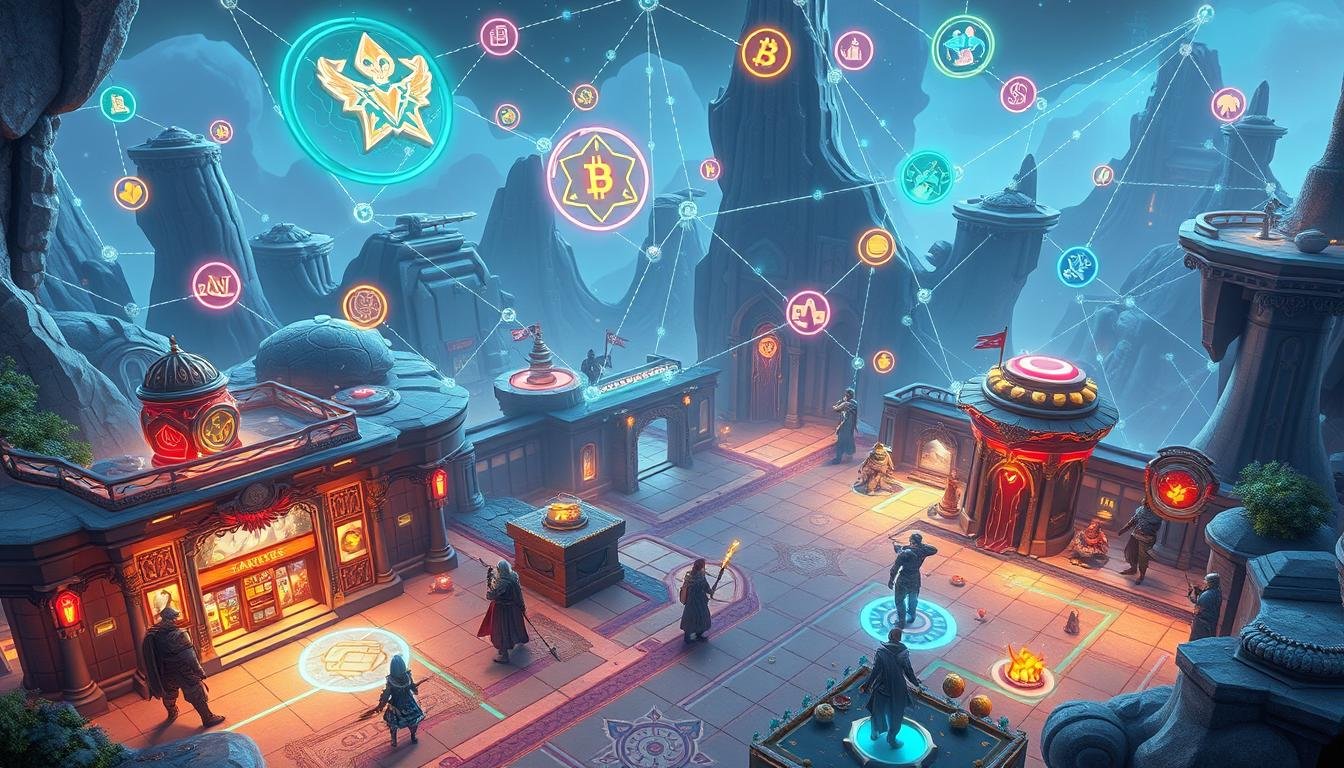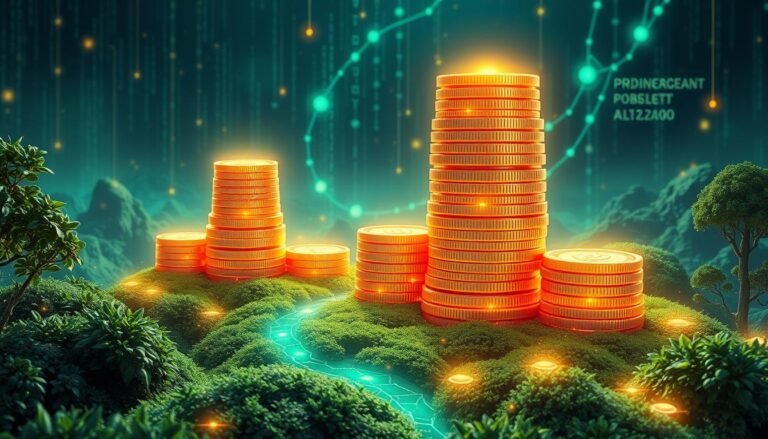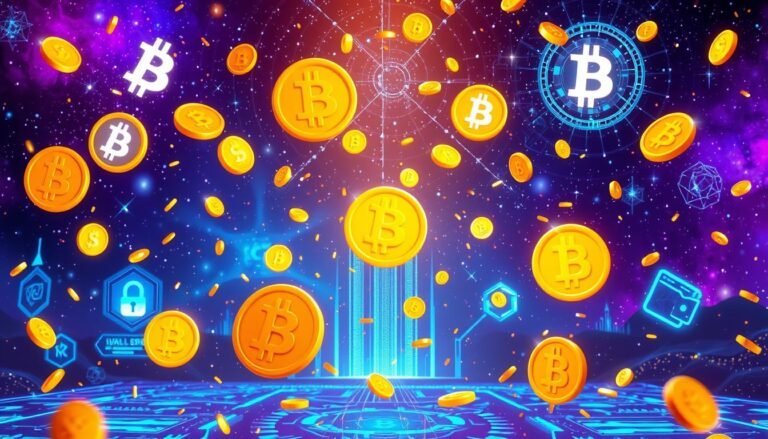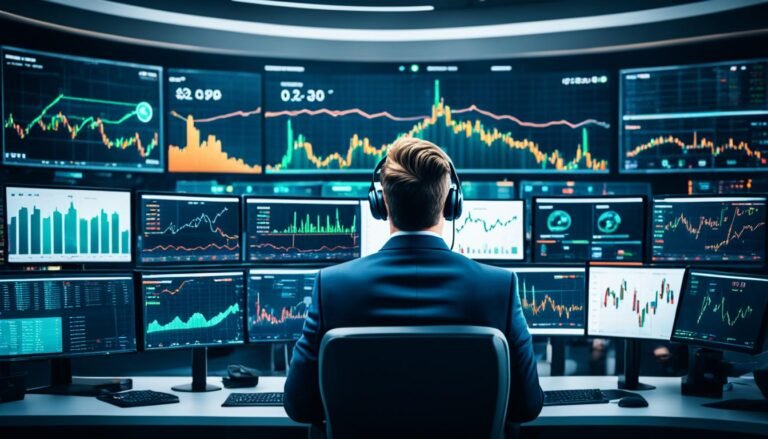Blockchain in Gaming: In-Game Economies
Blockchain technology has changed the gaming world. It lets games have open, fair, and player-led economies. Players can now own digital items and help shape virtual worlds.
Games use tokens for in-game items and money. This lets players earn and trade these assets freely. Blockchain gaming is making digital fun more real and exciting.
Key Takeaways
- Blockchain enables the creation of decentralized, self-sustaining economies in gaming through DeFi models, fostering player-controlled ecosystems.
- Non-fungible tokens (NFTs) in gaming represent unique assets like skins or weapons, offering real-world value to players.
- Cryptocurrencies are a critical component in blockchain gaming, allowing for the exchange of in-game tokens across platforms.
- Blockchain gaming allows players to truly own their in-game assets, enabling trading, selling, or transferring regardless of the game’s status.
- The Blockchain Gaming Industry is projected to be worth billions soon as it attracts millions of gamers and significant investments.
Blockchain-Based Gaming Economies: Tokenization and Ownership
At the heart of blockchain-based gaming economies is the concept of tokenization. In these virtual worlds, in-game assets and currencies are represented as digital tokens on a blockchain. This lets players truly own and trade their virtual possessions. It introduces a level of digital scarcity and transparent transactions that was impossible in traditional gaming environments.
Tokenization of In-Game Assets and Currencies
Blockchain games empower players by tokenizing in-game items, currencies, and other virtual assets. These tokenized assets can be bought, sold, and exchanged on decentralized marketplaces. This gives players greater control over the value and distribution of their virtual goods. It unlocks new gameplay experiences and revenue streams for both players and game developers.
Player-driven Economies and Decentralized Marketplaces
Many blockchain games incorporate play-to-earn mechanics. Players are rewarded with digital assets transparently and immutably. This provides tangible incentives for player engagement and participation in the in-game economy. Plus, the interoperability of blockchain gaming economies lets assets and currencies move seamlessly between different games and platforms. This creates a true cross-game asset ownership experience for players.
“Over 200 million players will be able to purchase skins for the Wild West-themed Web3 game Grit on the Epic Games Store and the Gala Games Platform.”
Cryptocurrencies: Fueling Blockchain Gaming
Cryptocurrencies are key in blockchain gaming, forming the basis of in-game economies. They differ from traditional virtual currencies because they can be used, traded, or sold outside games. This lets players turn their virtual money into real cash.
Token Development for In-Game Currencies
Token development services are essential for games to have their own tokens. These companies use blockchain to make secure digital assets for games. This integration allows for smooth transactions, boosting the game’s economy.
Cryptocurrency Exchange Platforms for Gaming Assets
Cryptocurrency exchange development has helped blockchain gaming grow. These platforms let players swap in-game tokens for other cryptocurrencies or even cash. This makes blockchain games more appealing, as players can earn real money.
The blockchain gaming market is expected to jump from $4.6 billion in 2023 to $65.7 billion by 2027. This shows a huge growth rate of 68.9%. It highlights the big role of Cryptocurrencies and Token Development in the future of In-Game Currencies and Cryptocurrency Exchanges in blockchain gaming.
“The implementation of regulatory frameworks across blockchain platforms is a major restraining factor for market growth.”
As blockchain gaming grows, using Cryptocurrencies, Token Development, and Cryptocurrency Exchange Platforms will be key. They will unlock the full potential of In-Game Currencies and help DeFi and Automated Transactions become more popular in gaming.
Blockchain in Gaming: In-Game Economies
In the world of blockchain gaming, NFTs have changed how players deal with in-game items. Each NFT is unique, perfect for rare digital items. This means players can own things like skins, weapons, and virtual land, which now have real value.
NFTs: Digital Scarcity and Ownership
NFTs in gaming bring digital scarcity to the table. Players can buy and trade rare digital items. This leads to player-driven economies, thanks to NFT marketplaces.
Players can now make money from their virtual wins. This builds strong economies in their favorite games.
Cross-Game Interoperability and Asset Portability
Blockchain gaming also makes it possible to use items across different games. This means players can use their NFTs in various virtual worlds. It’s a step towards a true metaverse, where players can move between games easily.
NFTs and blockchain gaming are creating a new era of in-game economies. Players can own, trade, and profit from their digital assets. As the metaverse grows, these innovations will change how we interact with virtual worlds.
Decentralized Governance and Community-Driven Gaming
The world of blockchain-based gaming is changing fast. Now, players have a say in how games are made. Decentralized Autonomous Organizations (DAOs) let players vote on game changes. This means games grow in ways that players really want.
Decentralized Autonomous Organizations (DAOs)
Blockchain games are using DAOs more and more. These are groups that make decisions together, openly and fairly. Players get to vote on game changes. This makes players feel like they own the game.
Web3 Game Development: A New Frontier
Web3 game development is leading the way in new gaming. It uses blockchain to make games fair and lasting. This new way of making games puts players first, making games better for everyone.
“The emergence of decentralized gaming has societal and economic implications, including the blurring of work and recreation boundaries and the potential for competitive gaming to evolve into a new type of sport allowing players to earn a living by honing their skills and managing in-game assets.”
The blockchain gaming market is growing fast. It’s expected to hit $10.7 billion by 2026. DAOs and Web3 game development are key. They make games fair, open, and good for everyone.
Crypto Wallets and Secure Asset Management
For players to enjoy blockchain gaming, they need secure Crypto Wallets. These wallets help store in-game tokens and NFTs safely. They also make transactions on decentralized exchanges easy and manage digital assets. Solutions for blockchain gaming often link directly with the game, making everything smooth and easy.
Crypto Wallets in blockchain gaming offer a big plus: secure transactions. They use blockchain’s decentralized nature to give players better asset management and ownership. This means less chance of theft or unauthorized access to their digital stuff.
| Key Crypto Wallet Features for Blockchain Gaming | Benefits |
|---|---|
| Secure Storage of In-Game Tokens and NFTs | Safeguards players’ digital assets from theft or loss |
| Decentralized Transactions on Blockchain Exchanges | Enables seamless trading and exchange of gaming assets |
| Integrated Game Interface | Provides a user-friendly experience, streamlining blockchain integration |
| Emphasis on Security and Tamper-Proof Ownership | Enhances player trust and confidence in the gaming ecosystem |
The blockchain gaming world is growing fast. The importance of Crypto Wallets in asset management and secure transactions will grow too. With these wallets, players can dive into decentralized gaming, keeping their valuable in-game assets safe and under their control.
Conclusion: The Future of Blockchain Gaming Economies
Blockchain technology has changed the gaming world. It brings us blockchain gaming economies that are open, fair, and player-led. Assets are tokenized, ownership is real, and new economic models like play-to-earn are introduced. This is reshaping how we play games.
The blockchain gaming world is growing fast. It shows in the rising value of blockchain gaming tokens and big deals in virtual land. Players now own their digital assets and can turn in-game money into real cash. This is a big change from old in-game economies.
The gaming world is moving towards decentralized governance and community control. The future of blockchain gaming looks bright. Players will have more power, and the line between virtual and real will blur. Blockchain is unlocking the gaming universe’s true potential, leading to a fairer, more sustainable future.
Source Links
- How Blockchain Technology Powers In-Game Economies and Cryptocurrencies?
- Blockchain in the Gaming Industry | Uniathena
- A Deep Dive into Blockchain-Based Gaming Economies
- What Is the Tokenization of In-Game Assets? | Chainlink
- Blockchain Gaming Business Research Report 2024-2030: Global Market to Grow by Over $305 Billion – Rising Popularity of Play-to-Earn Models Drives Growth, NFTs Expands Opportunities
- Blockchain Gaming Market Size, Share | Growth Report [2032]
- The Rise of Cryptocurrency in Gaming
- What Is GameFi? | Chainlink
- Decentralized Gaming and the Play-to-Earn Economy: Blockchain’s Revolution in Gaming
- The Decentralized Future of Blockchain Gaming | CoinFantasy
- Exploring Gaming Governance: DAOs in Gaming | CoinMarketCap
- Tokenomics in GameFi: Understanding In-Game Economies
- Blockchain Gaming: A New Era for Digital Assets in Banking – OneSafe Blog
- Addressing Security Concerns In Blockchain Gaming
- Where cash meets crypto
- The Role of Cryptocurrencies in Future Gaming Economies






